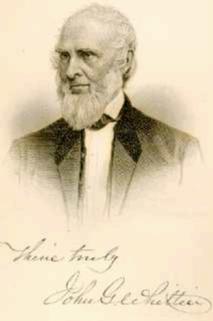| The Story of a Speech | ||
"sassing such famous littery people"
 [Description:
Portrait of Whittier.
]
[Description:
Portrait of Whittier.
]
By all accounts, including his own, the speech MT gave at the dinner for John Greenleaf Whittier was the most dramatic episode in his career on the dais. The date was 17 December 1877. The scene, Boston's Hotel Brunswick. The specific occasion, a celebration of Whittier's 70th birthday sponsored by The Atlantic Monthly. The larger occasion, as Henry Nash Smith points out, was a ceremonial tribute to the New England man of letters, as epitomized by Whittier and Emerson, Longfellow and Holmes (who were also at the banquet), as the guardian of American cultural values. In its account the next morning, the Boston Daily Advertiser called the assemblage "without doubt the most notable that has ever been seen in this country within four walls," and used names like "Shakespeare" and words like "holy" to express the event's significance (see excerpt). The long account in the Boston Daily Globe ran as the lead article, and printed many of the toasts and speeches, including MT's.
In his analysis of this event in Mark Twain: The Development of a Writer, Smith provides an excellent account of both MT's motivation for using his humor to deconstruct this cultural idol and middle-brow American society's angry response to the speech. On December 26, for example, the Globe reprinted an attack from the Cincinnati Commercial that accused MT of lacking "the instincts of a gentleman."
Below is the speech as MT re-presented it in the volume Mark Twain's Speeches (1910), where he followed it with his own "story" of its delivery and reception. His account, written almost 30 years later, only begins to indicate what was going on between the lines of the speech. His account can't quite speak for itself. It exaggerates, for example, the effect MT's irreverence had on the banquet; the scheduled speeches went on after he'd finished. And it doesn't mention the abject apology MT wrote a week afterwards to Longfellow, Emerson and Holmes. But the account is certainly a good guide to MT's emotional investment in the performance. (The best guide to the dynamics of his culture's response is Smith's chapter.) The one thing I've added, here, to MT's account are pictures of Longfellow, Emerson and Holmes — as MT's audience at the time would have seen them.
| The Story of a Speech | ||